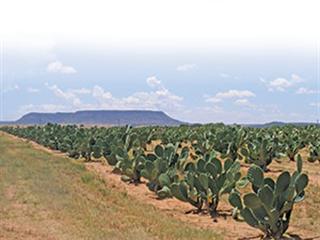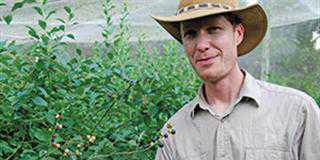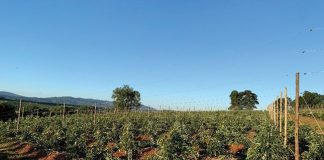
Danie van Tonder has been planting some 15ha to cactus pear on his farm Waterkloof in the Bloemfontein district since 1995. Cladode production forms 80% of his business and commercial cattle forms the rest. He plans to double the operation to 30ha. “We concentrate on cultivars that are adapted to our heavy clay soil but cactus pears flourish in any soil type. The trees will obviously do well in better soil types, but cactus pears are highly resilient, hardy and adaptable and an ideal alternative crop for semi-arid areas,” he says.
“In SA, we need to be water-wise. Large areas of the country receive very little rain and are subject to extreme temperatures. This is where the cactus pear comes in. Farmers in these areas – the Karoo and Kalahari – can very successfully establish a cactus pear orchard as an additional source of animal feed. “Because of the very low input costs, it is also a good option for emerging and township farmers.

Danie van Tonder
“Not only can the cladodes be used for feed but the fruit can also be sold for an additional income,” Danie continues.The average annual rainfall on Waterkloof is about 480mm with temperatures as low as -6°C in winter and as high as 38°C in summer. Heavy frost also occurs in winter. These extreme temperatures have little impact on cactus pear plants.
The plants can even be successfully cultivated in areas with temperatures as low as -10°C to -12°C. The commercial lifespan of a tree is between 50 and 60 years. Cladode yield on Waterkloof is 50t/ha fresh weight, at between 150 to 200 cladodes from an adult plant per year.
Varieties
Trials of all 42 cactus pear varieties in SA are planted on the land as part of an ongoing research project by the University of the Free State and the Agricultural Research Council. Danie uses the varieties Morado, Over, Rossa, R1 260, R1 259 and Gymno Carpo for cladode production as advised by the ARC’s Animal Production Institute.
“It is vital that the correct varieties are used. For instance, the Skinners Court variety bears very tasty fruit and is popular with consumers but its yields are low. Research is of the utmost importance to ensure long-term sustainability and profitability. But, given the current production of up to 200 cladodes per tree, it is easy to imagine what the potential for animal feed manufacturing is.”
The initial cladode cost is the main cost in establishing an orchard. Danie produces cladodes for planting and sells them for R6 each. The varieties can be confirmed through DNA testing to ensure that buyers get what they asked for. Each cladode is also dipped and treated against pests before leaving the farm. Cactus pears are prone to infestations by cochineal (Dactylopius coccus) and the cactus moth (Cactoblastis cactorum), which lays its eggs in the cladodes. Which is why Danie is strict about quality and exceptional phytosanitary standards. The cladodes are dipped in parathion before they leave the farm and plants are also sprayed.

Danie is investigating the possibility of using the cactus pear pulp, a by-product of cactus pear oil production, as silage.
Planting
A cladode is planted with one-third underground. Planting starts early in the rainy season. The plant density is about 800 to 1 000 plants per hectare and no fertiliser is necessary for the first year. No additional water is needed, but in very dry conditions, a little can be added to tide the cladode over until the first rain. Too much water can cause the plants to rot. An adult plant, for instance, can thrive on as little as 10mm of water at a time. Frost, however, damages the young cactus pear plants.
To maintain maximum yields, Danie applies a small amount of fertiliser to the adult plants. He says 200kg per hectare is more than sufficient. The type of fertiliser depends on the soil type and condition. For the first two years all fruit is removed to promote growth. The orchard must be kept free of weeds because excessive vegetation between the trees encourages
the development of the cactus moth. The orchards are inspected weekly to ensure early detection of pests. Trees older than a year are pruned each winter. Pruning is also important because fruit only forms on new growth.
Markets
Danie supplies cladodes for planting to virtually every corner of SA as well as Botswana and Namibia. “I specialise in providing cladodes for planting and do not manufacture animal feed for the market. I use this for my own commercial Bonsmara herd. The cladodes are usually cut up and left to dry for 72 hours and then put through a hammer mill,” Danie says.
“Mixed with lucerne or maize stover and a high protein concentrate, cladodes are an economical feed with an exceptionally high protein content. “I don’t market the fruit because we come in the market too late – usually after Christmas when the demand is low,” he adds.

Cactus pear seed oil is highly sought after in the cosmetic industry.
Cactus pear oil
Cactus pear oil production is another possible business opportunity that Danie is pursuing. It is highly sought after by the international cosmetic, pharmaceutical and food industries and is an exceptional source of Omega 6 oils. It can be compared to cotton seed and grape seed oil. “We extract the oil from seeds with a cold press method. An engineer and farmer from Wepener, MG Ingram, and I designed an affordable press that extracts the seed from the feed with less water than conventional presses. We are also looking at the possibility of using the pulp mixed with maize stover to make silage, but still have to determine the viability of such a venture.”
Contact Danie van Tonder on 083 411 6966 or email [email protected]













